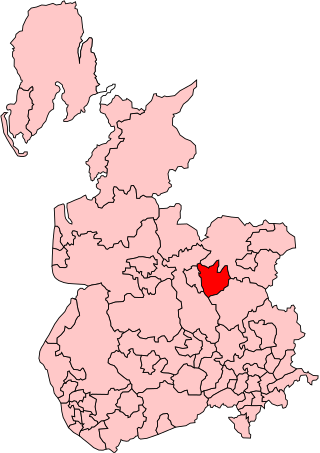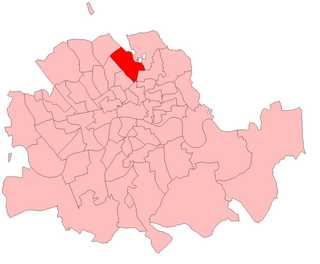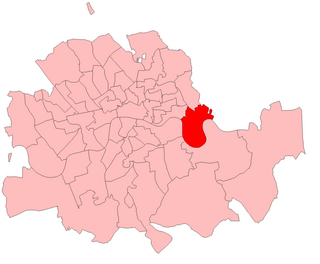London University was a university constituency electing one Member of Parliament (MP) to the House of Commons of the Parliament of the United Kingdom, from 1868 to 1950.

Accrington was a parliamentary constituency of the House of Commons of the Parliament of the United Kingdom from 1885 to 1983. It elected one Member of Parliament (MP) by the first-past-the-post system of election.
Luton was a constituency including the town of Luton in Bedfordshire. It returned one Member of Parliament (MP) to the House of Commons of the UK Parliament from 1885 to 1974, elected by the first past the post system.

Islington East was a constituency which returned one Member of Parliament (MP) to the House of Commons of the Parliament of the United Kingdom from 1885, until it was abolished for the February 1974 general election.

Clapham was a borough constituency in South London which returned one Member of Parliament (MP) to the House of Commons of the UK Parliament. It was created in time for the 1885 general election then altered in periodic national boundary reviews, principally in 1918, and abolished before the February 1974 general election. In its early years the seat was officially named Battersea and Clapham Parliamentary Borough: No. 2—The Clapham Division.

Salford South was a parliamentary constituency in the City of Salford in Greater Manchester from 1885 until 1950. It returned one Member of Parliament (MP) to the House of Commons of the Parliament of the United Kingdom.

Salford West was a parliamentary constituency in the City of Salford in Greater Manchester from 1885 until 1983. It returned one Member of Parliament (MP) to the House of Commons of the Parliament of the United Kingdom.
Stepney was a parliamentary constituency centred on the Stepney district of the East End of London. It returned one Member of Parliament (MP) to the House of Commons of the Parliament of the United Kingdom, elected by the first past the post system.
Whitechapel and St George's was a parliamentary constituency in east London, which returned one Member of Parliament (MP) to the House of Commons of the Parliament of the United Kingdom.

Whitechapel was a parliamentary constituency in the Whitechapel district of East London. In 1885 the seat was established as a division of the parliamentary borough of Tower Hamlets. It returned one Member of Parliament (MP) to the House of Commons of the Parliament of the United Kingdom.

Hackney Central was a borough constituency in what was then the Metropolitan Borough of Hackney, in London. It returned one Member of Parliament (MP) to the House of Commons of the Parliament of the United Kingdom.

Poplar was a parliamentary constituency centred on the Poplar district of the East End of London. It returned one Member of Parliament (MP) to the House of Commons of the Parliament of the United Kingdom.

Camberwell North was a borough constituency located in the Metropolitan Borough of Camberwell, in South London. It returned one Member of Parliament (MP) to the House of Commons of the Parliament of the United Kingdom. The constituency was created for the 1885 general election, and abolished for the 1950 general election.
Islington West was a borough constituency in the Metropolitan Borough of Islington, in North London.

Limehouse was a borough constituency centred on the Limehouse district of the East End of London. It returned one Member of Parliament (MP) to the House of Commons of the Parliament of the United Kingdom.

Bow and Bromley was a constituency in the Parliament of the United Kingdom. Located in the Metropolitan Borough of Poplar in London, it was created by the Redistribution of Seats Act for the 1885 general election and returned one Member of Parliament (MP) until it was abolished for the 1950 general election.
East Dorset is a former United Kingdom Parliamentary constituency. It was formally known as the Eastern Division of Dorset. It was a constituency of the House of Commons of the Parliament of the United Kingdom. It was represented by one Knight of the Shire.
St. Pancras South was a borough constituency represented in the House of Commons of the Parliament of the United Kingdom. It elected one Member of Parliament (MP) by the first-past-the-post system of election. It was created by the Redistribution of Seats Act 1885 for the 1885 general election and abolished for the 1918 general election.
St George was a parliamentary constituency in what is now the London Borough of Tower Hamlets. It was part of the Parliamentary borough of Tower Hamlets and returned one Member of Parliament (MP) to the House of Commons of the Parliament of the United Kingdom.

The Mile End by-election was a Parliamentary by-election held on 12 January 1905. The constituency returned one Member of Parliament (MP) to the House of Commons of the United Kingdom, elected by the first past the post voting system.




















